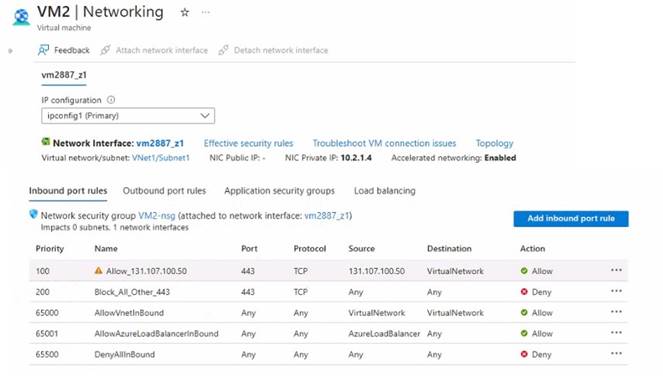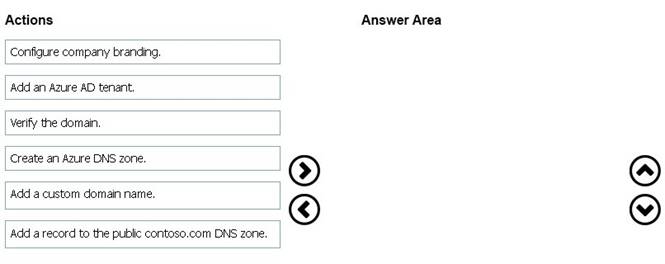- (Topic 5)
After you answer a question in this section, you will NOT be able to return to it. As a result, these questions will not appear in the review screen.
You have an app named App1 that is installed on two Azure virtual machines named VM1 and VM2. Connections to Appl are managed by using an Azure Load Balancer.
The effective network security configurations for VM2 are shown in the following exhibit.
You discover that connections 10 Appl from 131.107.100.50 over TCP port 443 fail. You verity that the Load Balancer rules are configured correctly.
You need to ensure that connections to Appl can be established successfully from 131.107.100.50 over TCP port 443.
Solution: You create an inbound security rule that allows any traffic from the Azureload Balancer source and has a priority of 150.
Does this meet the goal?
Solution:
Does this meet the goal?
Correct Answer:
A
- (Topic 5)
You have an Azure subscription that contains a virtual network named VNET1. VNET1 contains the subnets shown in the following table.
Each virtual machine uses a static IP address.
You need to create network security groups (NSGs) to meet following requirements:
✑ Allow web requests from the internet to VM3, VM4, VM5, and VM6.
✑ Allow all connections between VM1 and VM2.
✑ Allow Remote Desktop connections to VM1.
✑ Prevent all other network traffic to VNET1.
What is the minimum number of NSGs you should create?
Correct Answer:
C
Note: A network security group (NSG) contains a list of security rules that allow or deny network traffic to resources connected to Azure Virtual Networks (VNet). NSGs can be associated to subnets, individual VMs (classic), or individual network interfaces (NIC) attached to VMs (Resource Manager).
Each network security group also contains default security rules.
References:
https://docs.microsoft.com/en-us/azure/virtual-network/security-overview#default-security- rules
- (Topic 5)
Note: This question is part of a series of questions that present the same scenario. Each question in the series contains a unique solution that might meet the stated goals. Some question sets might have more than one correct solution, while others might not have a correct solution.
question in the series contains a unique solution that might meet the stated goals. Some question sets might have more than one correct solution, while others might not have a correct solution.
After you answer a question in this section, you will NOT be able to return to it. As a result, these questions will not appear in the review screen.
You have an Azure subscription that contains 10 virtual networks. The virtual networks are hosted in separate resource groups.
Another administrator plans to create several network security groups (NSGs) in the subscription
You need to ensure that when an NSG is created, it automatically blocks TCP port 8080 between the virtual networks.
Solution: You assign a built-in policy definition to the subscription. Does this meet the goal?
Correct Answer:
B
No, this does not meet the goal. Assigning a built-in policy definition to the subscription is not enough to ensure that when an NSG is created, it automatically blocks TCP port 8080 between the virtual networks. This is because there is no built-in policy definition that matches this requirement. The closest built-in policy definition is “Network security groups should not allow unrestricted inbound traffic on well-known ports”, but this policy only blocks TCP port 80 and 443, not 80801.
To meet the goal, you need to create a custom policy definition that enforces a default security rule for NSGs. A policy definition is a set of rules and actions that Azure performs when evaluating your resources2. You can use a policy definition to specify the required properties and values for NSGs, such as the direction, protocol, source, destination, and port of the security rule. You can then assign the policy definition to the subscription scope, so that it applies to all the resource groups and virtual networks in the subscription.
HOTSPOT - (Topic 5)
You have an Azure subscription that contains the storage accounts shown in the following table.
You need to identify which storage accounts support lifecycle management, and which storage accounts support moving data to the Archive access tier. What should you identify for each requirement? To answer, select the appropriate options in the answer area. NOTE: Each correct answer is worth one point.
Solution:
1) storage1, storage2, storage3
"Lifecycle management policies are supported for block blobs and append blobs in general- purpose v2, premium block blob, and Blob Storage accounts." https://learn.microsoft.com/en-us/azure/storage/blobs/lifecycle-management-overview
2) storage2
"The archive tier isn't supported for ZRS, GZRS, or RA-GZRS accounts." https://learn.microsoft.com/en-us/azure/storage/blobs/access-tiers-overview#archive- access-tier
Does this meet the goal?
Correct Answer:
A
DRAG DROP - (Topic 5)
You have an Azure Active Directory (Azure AD) tenant that has the initial domain name. You have a domain name of contoso.com registered at a third-party registrar.
You need to ensure that you can create Azure AD users that have names containing a suffix of @contoso.com.
Which three actions should you perform in sequence? To answer, move the appropriate cmdlets from the list of cmdlets to the answer area and arrange them in the correct order.
Solution:
The process is simple:
✑ Add the custom domain name to your directory
✑ Add a DNS entry for the domain name at the domain name registrar
✑ Verify the custom domain name in Azure AD
References: https://docs.microsoft.com/en-us/azure/dns/dns-web-sites-custom-domain
Does this meet the goal?
Correct Answer:
A

